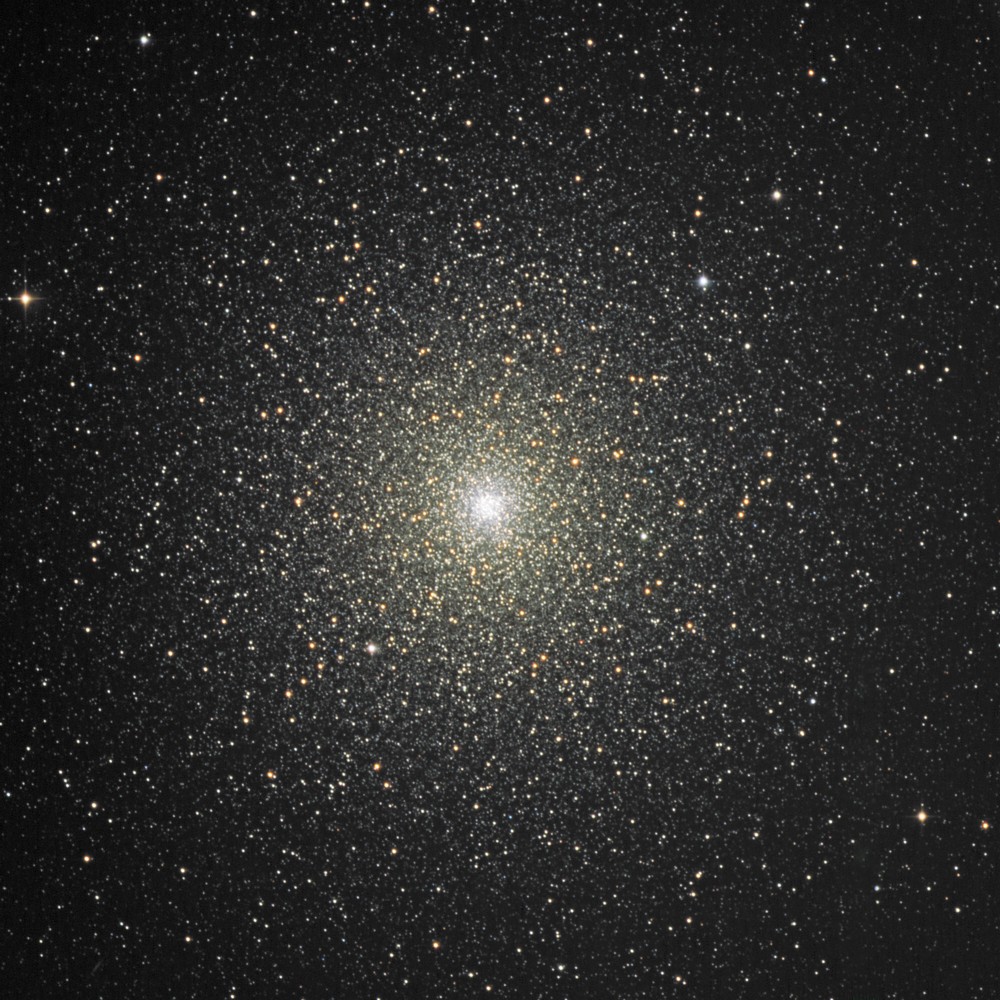So... globular clusters are not my favorites because they are not so colorful. Anyway...
Let's compare the two largest globular clusters of the Milky Way!
Millions of Stars in Omega Centauri
Image Credit & Copyright: Massimo Di Fusco and Mirco Turra
Let's look at some differences. First, however, bear in mind that the pictures may not be directly comparable. The scale and "degree of closeup" may be different, and the sizes of the images are definitely different - the Omega Centauri image is almost 2 MB, whereas the 47 Tuc image is some 300 KB.
According to an old catalog of mine, Sky Catalogue 2000.0 Vol.2, globular clusters are classified according to their degree of concentration. The most highly concentrated globulars are class 1, while the loosest ones are class 12. According to Sky Catalogue 2000.0 Vol.2, Omega Centauri is class 8, so it's fairly loose. 47 Tuc, on the other hand, is class 3, so it is much more concentrated. And you can see in Don Goldman's picture how concentrated its center is.
Another aspect of globular clusters is their metallicity, typically measured as how much iron they contain relative to hydrogen compared with the Sun. If the metallicity, [Fe/H], is -2, it means that each member of the globular contains, on average, 1/100 as much iron relative to hydrogen as the Sun. Well, the metallicity of Omega Centauri is -1.59, and the metallicity of 47 Tuc is 0.79. So both Omega Centauri and 47 Tuc are metal-poor compared with the Sun, but Omega Centauri is more metal-poor than 47 Tuc.
And this has consequences. What it means, in particular, is that Omega Centauri contains a class of evolved blue stars, blue horizontal branch stars, but 47 Tuc lacks them.
When you compare the color-magnitude diagrams of Omega Centauri and 47 Tuc, your first question is probably, Why are the "undersides" of the color magnitude diagrams so different for Omega Centauri and 47 Tuc? Well, I guess that the lower part of the Omega Centauri diagram has just been cut off, so that it doesn't show us the faintest, reddest stars. Note that the reddest, faintest stars of the Omega Centauri diagram have a B-V index of about 0.5, whereas the reddest, faintest stars of 47 Tuc have a B-V index of about 1.8. We can be sure that the there are small red stars in Omega Centauri that are as red as the faintest red stars of 47 Tuc, but we don't see them in this diagram.
There is a Hubble closeup of stars inside Omega Centauri. If you ask me, the colors are pretty horribly saturated and "too much", but you can certainly see that there are blue stars inside Omega Cen. There is also a picture of 47 Tuc that shows you that there are no blue stars here. (Yes, there
are blue stragglers in 47 Tuc, stars that have accreted gas from a companion star and grown hotter and bluer than they "should" be, but the blue stragglers are so few and far between - and fairly faint, too - that they don't affect the overall color of the cluster.)
As a consequence, because there are blue stars in Omega Centauri but not in 47 Tuc due to its higher metallicity, Omega Centauri is whiter in overall color than 47 Tuc. The B-V of Omega Centauri is 0.68, which is just a hair yellower than the B-V index of the Sun, 0.656, (or the B-V index of Polaris, 0.636). The B-V index of 47 Tuc, by contrast, is 0.89, which is a little yellower than Capella (0.795).
Omega Centauri is really different from most other Milky Way globulars, and it is certainly different from 47 Tuc, in that it is believed to be the core of a dwarf galaxy cannibalized by our own big bully of a galaxy.
Small spiral galaxy NGC 300 may just possibly be similar to the dwarf galaxy that was captured by the Milky Way, and whose core became Omega Centauri. The best picture I could find of the core of NGC 300 is printed on a zip pouch!
The Milky Way has cannibalized many small galaxies over its many billion-year life time. The hapless small galaxies have left their marks on our galaxy in the form of stellar streams.
Is there a stellar stream connected to Omega Centauri, too? Yes, apparently, a small one! It's called the Fimbulthul stream, and it was discovered only in 2019. Its mass is just 318 solar masses, so it's a lightweight stream for sure!
And that's all for me! I'm off!
Ann
 Millions of Stars in Omega Centauri
Millions of Stars in Omega Centauri










